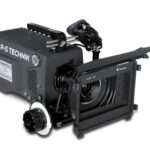
Class Of The Field?
Posted on Sep 20, 2011 by Alex Fice
The Sound Devices PIX 240 recorder with timecode generator, HD-SDI and on board hardware scalerWill the champions of the location sound field recorders be able to win over the video fraternity? The PIX recorders are late to market but do have some special features to tempt us.
If you ask location sound recordists why they like Sound Devices’ products so much, most of them will say ‘attention to detail’. Adam Garstone who is a location sound man (amongst other things) said about the sound products, “They work just how you want them to work – there is none of the clunky, clumsiness of their rivals. Their timecode support is excellent (a troubling weakness in cheaper recorders) and they are incredibly reliable.”
They’ve made it, they are the Rolls Royce of the sound recorder so why have they decided to make video recorders for the production community in an already crowded market. Jon Tatooles, MD of Sound Devices explains that in the production world work practices and workflows are converging, “These recorders are our first video products. The dynamics of production whether it’s audio or picture seem to be converging especially as things are moving towards a more file based element for both. Many of the workflow questions that we have received over the years for our sound products are in fact video questions too. Most of them are about synchronisation and frame rates so we saw that as an opportunity to come up with a video product.
“We saw we could take advantage of these digital bitstreams, we don’t have any analog inputs apart from the audio inputs on these recorders. They are taking digital files or signals from digital cameras, going through a codec, recording them in a very similar topology to our ‘7’ series audio recorders. So in the back end they are a lot of similarities of what we’ve already developed in terms of workflow, metadata handling, these are things that the video side has started to need.”
But is this enough to market a product in a different market albeit in the same industry? Jon is confident that many of his sound customers are camera operators too who would start the sales ball rolling. “To some extent we’re addressing those first customers that we addressed with the field mixers – many camera operators have Sound Devices sound mixers as part of their kit. We’re essentially giving them another tool in their arsenal.”
But beyond these initial customers, where is the market? “We see that in production people’s requirements are continually evolving and exactly where our video products take us to some extent is unclear. We’re going to evolve as the workflows evolve which is the same thing that we’ve done with our recorders. For our ‘7’ Series recorders in just over six years we’ve had 30 firmware updates, so we’ve evolved as production has evolved.”
Sound Devices always wanted the flexibility of offering multiple codecs for the video products, “The architecture of the product is such that as codecs evolve we can evolve too. The product is ProRes and DNxHD in the revision one software. We know that’s going to be a changing landscape.
“The reality is that on the sound side uncompressed audio, a 24/48 broadcast wave file is the standard for production sound, that’s not going to change. In the video world there are products that exist for an uncompressed workflow but we see that they’re are some very high quality codecs that can reduce the data rate. We’re not targeting an uncompressed world.”
 With PIX you are buying a brand known for reliability and huge acceptance from the audio industry but at a price, the 240 is nearly USD$3,000The question for Sound Devices maybe isn’t the codecs they carry, at the moment it’s a ProRes device primarily as DNxHD carries a license fee ordered by AVID. The question is will cameras operators pay the extra for the bullet-proof reputation that the sound recorders have earned over the years? To this end the PIX comes in two forms the 240 and 220, one with HD-SDI and HDMI and one only with HDMI (there are more differences between the two models like a timecode generator on the 240 and not on the 220). Both the PIX 220 and PIX 240 offer powerful, hardware-based video scalers. Realtime conversion among video formats, including 1080i, 1080p, and 720p, are set with a menu selection. Conversion between interlaced and progressive, as well as frame rate conversion is available in realtime. For instance, some cameras set to record 24ps send 1080i 60 over HDMI or HD-SDI. PIX recorders can be set to convert the 1080i 60 stream back to 24p with no loss in quality.
With PIX you are buying a brand known for reliability and huge acceptance from the audio industry but at a price, the 240 is nearly USD$3,000The question for Sound Devices maybe isn’t the codecs they carry, at the moment it’s a ProRes device primarily as DNxHD carries a license fee ordered by AVID. The question is will cameras operators pay the extra for the bullet-proof reputation that the sound recorders have earned over the years? To this end the PIX comes in two forms the 240 and 220, one with HD-SDI and HDMI and one only with HDMI (there are more differences between the two models like a timecode generator on the 240 and not on the 220). Both the PIX 220 and PIX 240 offer powerful, hardware-based video scalers. Realtime conversion among video formats, including 1080i, 1080p, and 720p, are set with a menu selection. Conversion between interlaced and progressive, as well as frame rate conversion is available in realtime. For instance, some cameras set to record 24ps send 1080i 60 over HDMI or HD-SDI. PIX recorders can be set to convert the 1080i 60 stream back to 24p with no loss in quality.
“The PIX products have come in at what we think is a very competitive price point. USD$2800 for the PIX 240 without media and the 220 at just under USD$2000. But we’ve done that without compromising the quality. Camera operators have a lot of things to consider so we designed the user interface as simply and fast as possible. We also have the benefit of a screen to simplify navigation and it can also act as a monitor as well.” The monitor is only 800×480 pixels.
Jon naturally uses his sound products great reputation as a major buying decision for his new video products. He also sees his video products fitting in to most workflows even for movies where he sees PIX as being used for proxy ProRes files when you just need to see how things are working, he used RED as an example for this, but doesn’t RED produce its own proxy files?
PIX were first seen at this year’s NAB and they are nearly shipping products. There have been a few changes including a bigger screen to five inches. They’ve also made some important relationships with camera manufacturers to make sure metadata would carry over and camera quirks could be ironed out.
Whether PIX’s lateness to the market goes against them only time will tell.








